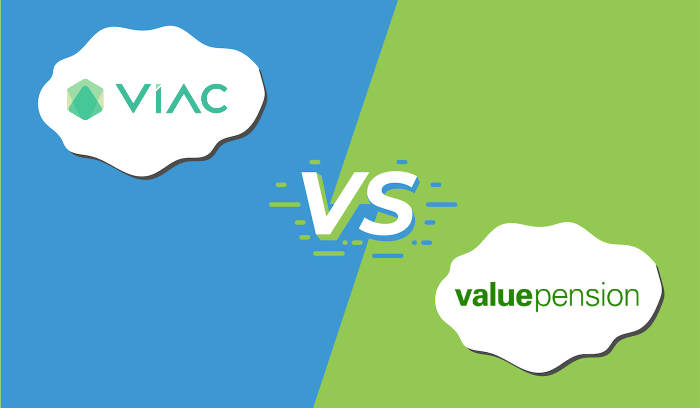VIAC vs valuepension – Which is best for your 2nd pillar pension fund?
At Investing Hero, we aim to provide the best investing platform reviews. To support this, some of the providers featured in reviews will generate an affiliate commission which helps pay to run this website. However, this doesn’t influence our reviews. Our opinions are our own. The information provided on Investing Hero is for informational purposes only. Please read our disclaimer.
In this VIAC vs valuepension article I’ll be comparing the second pillar (aka vested benefits account) offering from two of the leading providers in Switzerland. If you are looking for the review on the Finpension third pillar, that’s over here.
But before we get started, a quick recap.
A vested benefits account is related to one of the three pillars of the pension system in Switzerland – the second pillar specifically, which concerns occupational contributions. If you are in full time employment, you and your employer will be paying into this fund already.
However, if you change jobs, reduce your hours significantly or plan to leave Switzerland – the second pillar should be a topic on your radar to maximise your future wealth. These contributions will need to ‘parked’ until your situation changes again, such as coming back from a career break.
So, with the recap out the way – lets move onto the VIAC vs valuepension comparison.
Both have a great offer which is leagues ahead of the more traditional options *cough* your existing bank *cough* in terms of pricing and flexibility around building a portfolio.
Let’s dig into the details.
🎁 If you are ready to try a free Valuepension demo, don’t forget to use this link to open your free account and you can get started in under 5minutes!
VIAC vs valuepension: Pros and Cons
In my opinion here are the top pros and cons for both VIAC and valuepension, you can scroll down for greater detail on the comparison table.
VIAC compared to valuepension
I’ve talked about VIAC in the past as it relates to their third pillar option, which is one of the market leaders in Switzerland. But I haven’t look at their vested benefits offering yet, which was launched earlier this year. Below you’ll find my thoughts on the top pros and cons of the VIAC offering.
| Pros | Cons |
|
|
Valuepension compared to VIAC
I’ve created a full valuepension review in the past which goes into more detail on the account opening process and offers some more background on the company. Be sure to check it out. As before, here are my top pros and cons:
| Pros | Cons |
|
|
VIAC vs valuepension comparison
I’ve compared the two side by side in the comparison table below. Hopefully this helps you make an informed decision best suited for your needs, and as you can see they are both very similar but with a slight edge toward valuepension.
Please note this is purely related to the vested benefits 2nd pillar pension, and not the third pillar pension.
| VIAC | valuepension | |
| Management fee | 0.51% | 0.49% |
| Currency exchange fees | 0.05% | 0 |
| Stock allocation | 97% | 99% |
| Domicile of foundation | Basel | Schwyz |
| Bank where assets are stored | WIR Bank | Credit Suisse |
| Country where assets are stored | CH | CH |
| Sustainability investing options | Yes | Yes |
| Two factor authentication | Yes | Yes |
Account opening process
Both VIAC and valuepension offer a hassle free account open process which is quick, simple and pain free. They each offer very similar steps to get started, with almost the same ‘3 step’ (maybe they inspired each other 😉 ) process to get started.

A few clicks with VIAC or valuepension, and you are on the way.

We won’t go through every step in the account process as that’s covered in my blog elsewhere, but overall the process is excellent for both and there are no flags at this stage. Everything just works.
VIAC have spent a little more effort around the UX elements (branded styling, icons etc) which makes for a more visually appealing onboarding, but valuepension excels in it’s simplicity.
Portfolio comparisons
As you would expect, both offer a comprehensive range of portfolio options to invest your pension.
And both are very much the same in terms of how they are structured – no real surprises.
You can have anything from 0% stocks, all the way up to over 90% with either platform, and they both leverage index funds to keep costs low and maximise your gains over the long term.
The VIAC portfolios are a little easier to digest in my opinion, mainly due to how they are presented in a simple table view:

valuepension on the other hand, you need to scroll through a series of pie charts. Not a deal breaker.
As said, the portfolios are very similar. However, valuepension has the edge as you can customize the weighting in extreme detail, all the way up to 99% stocks, and you have a high level of control on exactly what and where your portfolio is invested.
Login & Security
SSL encryption and https connections are standard for both platforms and two factor authentication is used to access and make changes within the account. As I mentioned in my valuepension review, you are not actively trading and transacting in your accounts – it’s more a ‘read only’ view of your portfolio.
Technical security aside, vested benefit funds in Switzerland are arguably amongst the safest in the world. With strict Swiss regulation concerning pensions, your assets are not on the balance sheets of either firms and are held directly in your name. Should something happen to either valuepension or VIAC, your fund will still be there, and can be moved to another asset manager.
Fees & Charges
As with other parts of this viac vs valuepension comparison blog post, the fees are also very close between the two . However, valuepension have the edge with a 0.49% base management fee vs the 0.51% base fee from VIAC.
VIAC also have a few extra % to add on in the form of currency exchange rates, around 0.05%, so another small win for valuepension.
Keep in mind, while these differences are small, the very nature of a pension fund is that it’ll be used as a pension – which for most of us is a long way off. The small fee differences, over 20-30+yrs, do make a impact over the long term.
It’s worth noting the valuepension have a few ‘admin’ related fees for things such as pledging the pension for your mortgage (200 CHF), if you leave the pension fund in under a year (400 CHF) or move abroad and withdraw it (500 CHF). VIAC have none of these admin costs. However in the last case of a fee for moving abroad, it’s important to remember valuepension is founded in canton Schwyz which has a significantly better tax rate (just 4.8%) when compared to VIAC’s fund based in Basel.
This will save you thousands of CHF once you’ve built up a large pension pot – which pales in comparison to a 400CHF withdrawl fee.
Customer Support
Customer support really can’t be separated between the two firms – both are excellent, responsive and highly knowledgeable. Both firms also support English perfectly, which is great for us. It’s worth noting VIAC also offer their website and support in Italian. Grazie mille, VIAC.
Both sites have a good deck of FAQs which cover all the pain points and a useful reference to clarify details on costs, account opening and portfolio creation.
Additional Resources
On the valuepension site, there isn’t a huge amount of content as the interesting blog articles can be found on the parent site, finpension.ch. This blog is worth checking out, with a number of solid articles and blog posts on various pension topics. For a company blog, they offer a lot of good value.

VIAC don’t have a blog, but maintain a ‘Knowledge base’ which covers the basics, but is a little lacking when compared to the content being put out by the folks at valuepension.
Closing thoughts
To be honest, picking a ‘winner’ between these two is really tough.
However taking in everything outlined above – from costs, portfolio customization and flexibility to max up to 99% in stocks – valuepension have the edge as being the better long term solution for a vested benefits account. And if you plan on leaving Switzerland, the tax breaks from a fund in canton Schwyz can’t be ignored.
That said, the VIAC vested benefit plan is definitely not a bad choice, with some nice perks like death and disability insurance, and when you compare to other options from traditional banks – both firms are in a different league. It’s refreshing to have two such great choices to park your vested benefits.
Thanks for reading and I hope you enjoyed this viac vs valuepension comparison!
🎁 If you are ready to try a free Valuepension demo, don’t forget to use this link to open your free account and you can get started in under 5minutes!
About Investing Hero

I’m a British expat who’s been living in Switzerland for the last 10 years. I’m a digital marketing professional by day, and anonymous investing blogger by night. I cover investing basics, robo advisor reviews and epic how to guides. You can call me ‘Mr. IH’ for short, and read more about me here.


